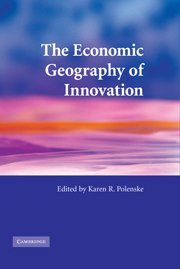Book contents
- Frontmatter
- Contents
- List of figures
- List of tables
- Notes on contributors
- Acknowledgments
- Abstracts
- List of abbreviations and acronyms
- Part I Concepts and measurements in innovation
- Part II Institutional and spatial aspects of information and knowledge flows
- Part III Institutions and innovation systems
- 10 National systems of production, innovation, and competence building
- 11 Perspectives on entrepreneurship and cluster formation: biotechnology in the US Capitol region
- 12 Facilitating enterprising places: the role of intermediaries in the United States and United Kingdom
- 13 Innovation, integration, and technology upgrading in contemporary Chinese industry
- 14 Society, community, and development: a tale of two regions
- Index
- References
14 - Society, community, and development: a tale of two regions
Published online by Cambridge University Press: 22 September 2009
- Frontmatter
- Contents
- List of figures
- List of tables
- Notes on contributors
- Acknowledgments
- Abstracts
- List of abbreviations and acronyms
- Part I Concepts and measurements in innovation
- Part II Institutional and spatial aspects of information and knowledge flows
- Part III Institutions and innovation systems
- 10 National systems of production, innovation, and competence building
- 11 Perspectives on entrepreneurship and cluster formation: biotechnology in the US Capitol region
- 12 Facilitating enterprising places: the role of intermediaries in the United States and United Kingdom
- 13 Innovation, integration, and technology upgrading in contemporary Chinese industry
- 14 Society, community, and development: a tale of two regions
- Index
- References
Summary
Contrasts in innovation: why should low-tech be so difficult?
Tonalá, near Guadalajara in the state of Jalisco, Mexico, provides the first-time visitor with the impression of a typical Mexican town with narrow, cobbled streets and small adobe houses whose front rooms double as stores. The town center is traditional Mexican plaza style. The streets are clean and well-cared for, with cheerful brightly colored facades; every morning, each family cleans its sidewalks in front of its shop. Overall, there is a jumble of production, residential, and sales spaces. People are all around, with workers moving ceramic products, while trucks almost too large for the narrow streets are crammed full of products, leaving for far-flung destinations, to be sold in American and European chain stores. Hundreds of stores line the streets, one after another, offering a wide array of “typical Mexican” handicrafts. On the two big market days each week when goods are sold not only in shops, but in street markets, people arrive from all over to buy ceramics, furniture, blown glass, and other decorative objects. The work areas are low-tech and work is hard, but the overall feeling is of bustle but not oppression; this is not surprising, since many of the firms are family-owned and operated, and, in many, the owners are former workers in other firms.
On the other side of the Guadalajara metropolitan area, the main street of the town of Tlaquepaque is lined with magnificent colonial houses, the central plaza has a baroque cathedral, and there are fine restaurants, bars, cafes, and high-quality boutiques throughout the town.
- Type
- Chapter
- Information
- The Economic Geography of Innovation , pp. 310 - 339Publisher: Cambridge University PressPrint publication year: 2007
References
- 7
- Cited by



